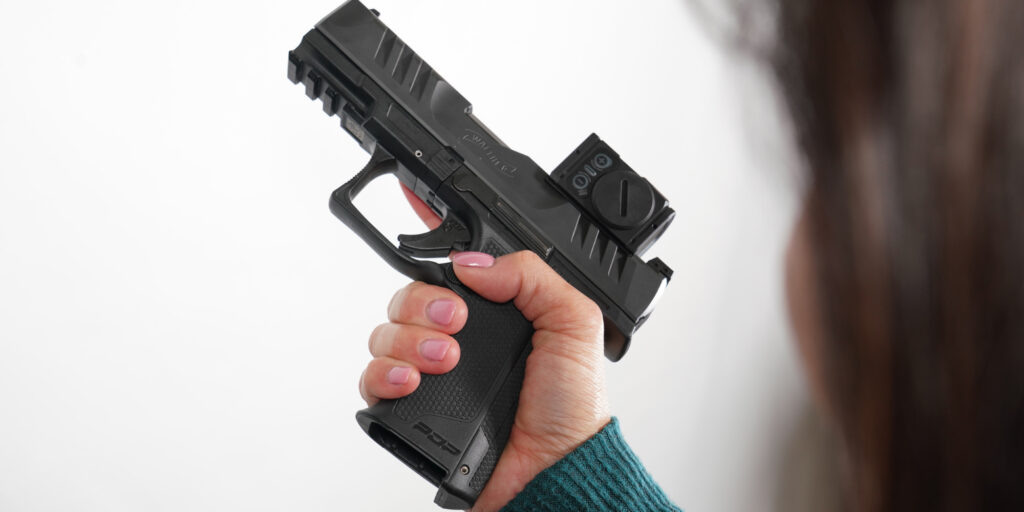This diminutive member of Walther’s flagship line makes it possible to own one gun for protection, practice, and competition.
Walther’s signature line of striker-fired “performance duty” pistols, or PDPs, was conceived and has emerged to be the flagship gun of the company’s traditionally hammer-fired guns. The smallest choice among them bears the (in my opinion) unfortunate moniker of PDP-F, the “F” indicating its intended design for female shooters. Fortunately, smart consumers of both sexes recognize this gun as worth owning for multiple purposes.
I’ve owned and tested multiple PDPs of various barrel lengths, and have developed a great fondness for these guns thanks to their reliability, excellent stock triggers, and solid red dot sight (RDS) mounting systems. These are described in plural on purpose as there have been two trigger and sight mount designs in the product line, both of which I’ve personally owned. They all work well.
PDP-F Features
The PDP-F may have been designed as a women’s pistol in that it’s small but not tiny and has a short distance between the top of the backstrap and the front surface of the curved trigger. Its capacity is robust for its size at 15 rounds.
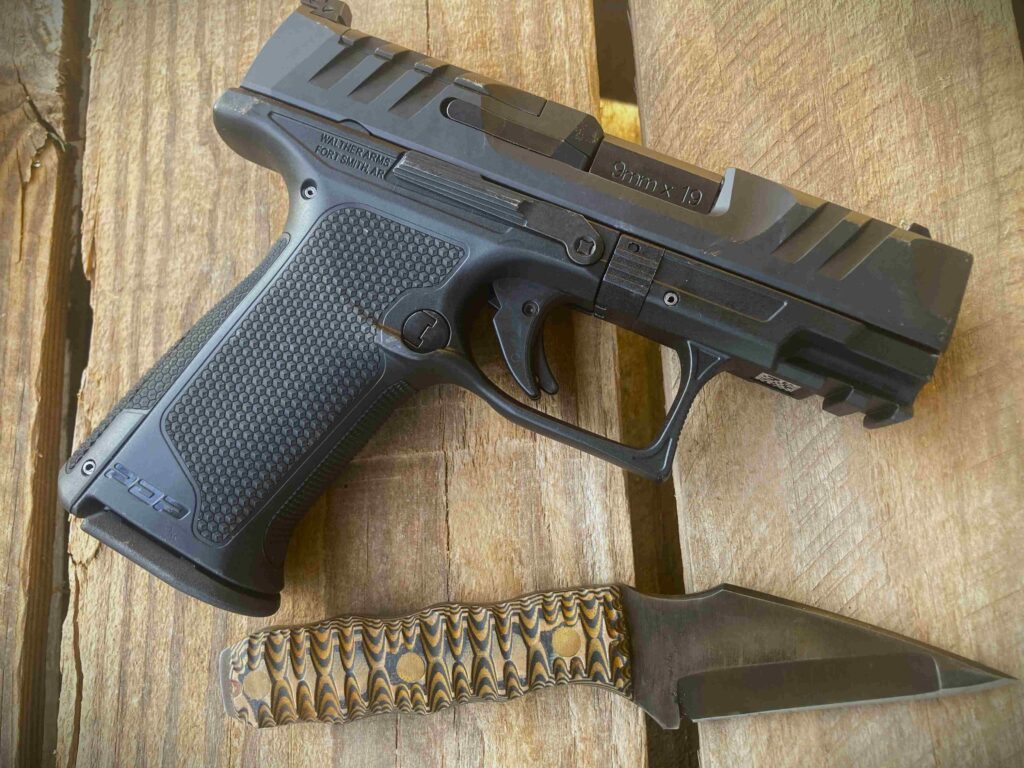
Walther PDP-F with Ambi-Controls
Like other PDPs, the F has a relatively straight grip angle and a slide that’s on the squarish, bulky side. It’s also ready for carry-size optics with a pre-milled slide that, along with the company’s well-made mounting plates, can play host to any popular compact reflex sight. While I didn’t have an optic to mount on this gun, my standard PDP’s mounting setup has proven solid for more than two years.
This gun ships with two 15-round magazines. It’ll also run both generations of Walther’s 18-round PDP magazines (the company doesn’t advertise this but I tried both, and they work). The reversible mag release is easily operated and mags fall freely in any load condition. A nice molding around the bottom front quadrant of the release prevents unintended releases during firing.
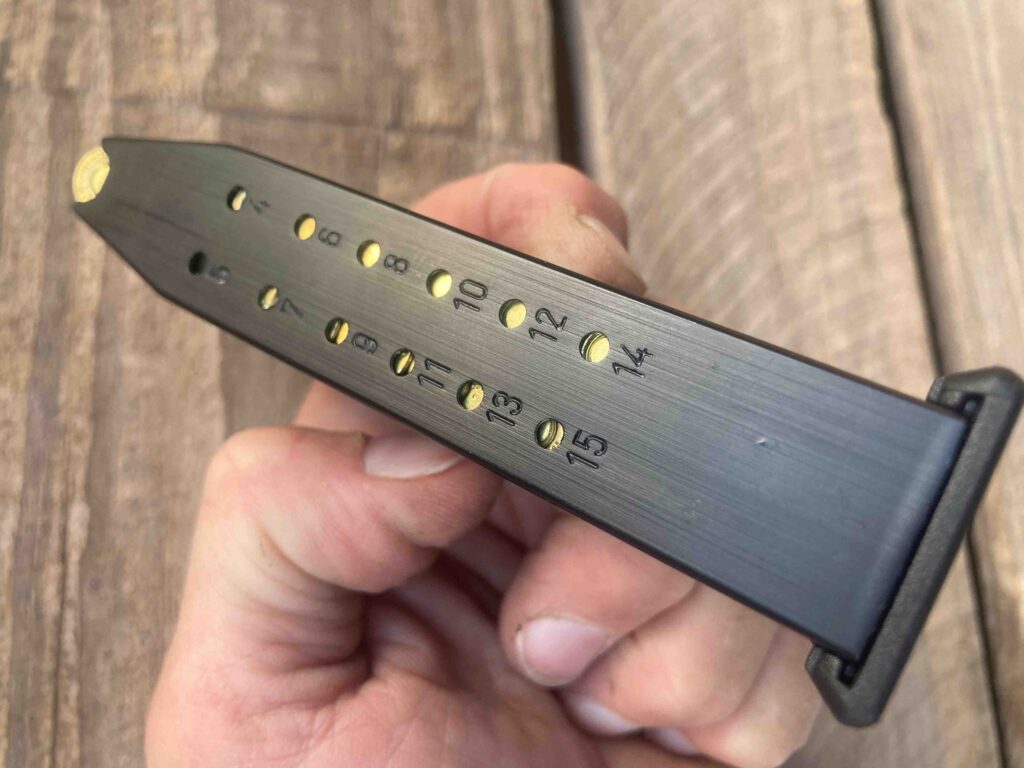
Stamped metal 15-round magazine. The firearm comes with two magazines in the box.
Sighting with the PDP-F is easy using the windage/elevation-adjustable rear sight. The sights are on the tall side and can reasonably co-witness with some optics. This I know thanks to having the same sights on my stock PDP. For the price of this gun, I do think Walther could’ve included tritium.
The polymer frame comes with two backstraps, one of which is only slightly thicker on the bottom rear. A punch or similar tool is required to remove the rolled metal pin and perform the change-out. Here again, Walther could’ve done better by using a polymer pin. The end that’s pushed on tends to wallow a bit.
Speaking of metal components, I’m glad Walther is sticking with polymer magazine floorplates on the PDP-F, whereas several other PDPs have painted aluminum bases. Experience has shown that the finish on the painted ones doesn’t last long, marring appearance if not function of the mags.
Nobody likes a slippery grip. The PDP-F will save a lot of people the trouble of stippling thanks its moderately aggressive grip design of tiny raised pyramids. The backstrap is especially grippy, but not rough. Excellent grip traction is a big breason this gun is so easy to handle compared to some others in the sub- and micro-compact classes.
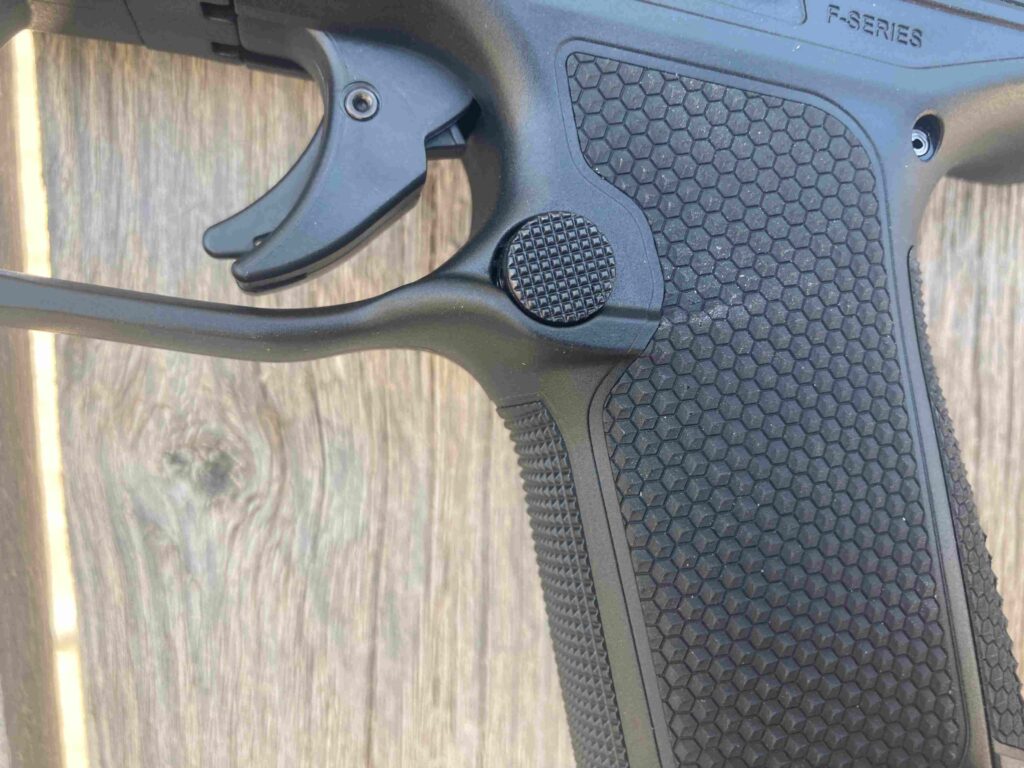
Walther PDP-F Grip Controls are on-point!
Walther placed the grip as forward as possible where it joins the slide and used a fairly straight grip angle, making the web-of-hand-to-trigger distance as short as possible. The trigger guard Is like any other PDP’s, which is to say it’s oversized and square. There is a tiny, two-channel Pic rail on the front end of my test gun with the shorter, 3.5-inch barrel. The 4-inch version of the PDP-F has a more versatile three-gap rail.
As far as I’m concerned, the crowning feature of the PDP-F is the long and ambi slide lock. This is a feature many gun makers have finally caught on to, and I’m glad. Likewise the mag release is reversible, with moulding only underneath so as to prevent unintentional release. These features make operating the PDP-F like a pro accessible for most shooters regardless of hand size or hand dominance.
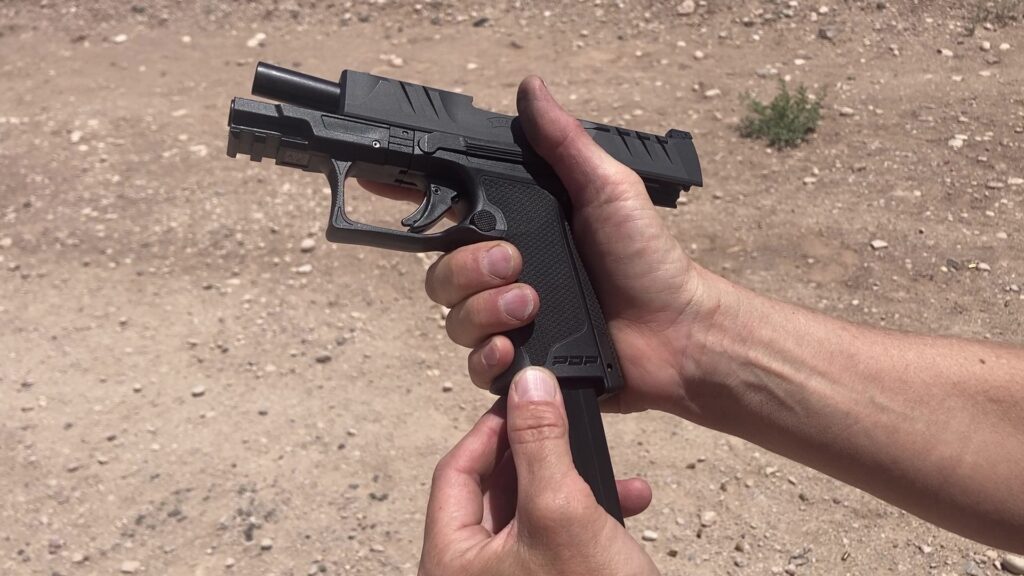
Walther employs internals that make the F model’s slide a bit easier to rack. It’s not on the order of, say, the M&P E-Z series, but it is perfectly doable. Bigger guns are easier to handle because gross motor action is used for functions like racking rather than the fingertip-handling required by some small guns. The PDP-F offers big gun ease on a small frame.
If you’re a full-size optic on a carry-size gun kinda person, you’re in luck. New PDP-Fs come with the second generation of Walther’s plate mounting system. It’ll accommodate pretty much any full-size optic. I kinda wish they’d made this model for carry optics though. As a longtime user of their 1.0 system and with some mileage on the 2.0 plate, I can attest to the mount being as close to rock-solid as possible with correct installation, of course.
PDP-F in Action
You know how some guns just feel right when you pick them up? The PDF-F seems to have that effect on more people than most any other model of any type or brand, assuming said person is willing to consider being pleased by a subcompact, polymer-lower gun.
Shooting this thing is pure enjoyment. It feeds and fires every time regardless of ammo type. The mags drop freely when released, regardless of load condition. It’s small but big enough to establish a good grip. And recoil is very manageable, even in the 3.5-inch-barrel version.
My medium hands do have to lighten the grip just a bit when slamming the 15-round mag home. Shooters with large hands might be bothered by the pinch factor here. If concealability isn’t a concern, this problem is resolvable by using 18-round mags for a full-size PDP. Both the polymer and aluminum floorplate mags work in the F model. Sure, it’s a tad unsightly, but pretty is as pretty does.
There is a massive market for subcompacts that are grown-up models of the micro version within the concealed carry community, particularly for men and the segment of women who have the physical space for a longer barrel and find that a longer barrel, in the right holster, can make it easier to conceal the grip when w concealing in the appendix position. Think Hellcat Pro or P365 XL, both popular with male concealed carriers. At the same time, this gun is ideal for most any female shooter, most of whom have shorter fingers, who are or are becoming competent at marksmanship and gun handling. It handles extremely well.
Walther has long had a reputation for good triggers, and the one on the PDP-F follows that tradition. It’s not the super-short break and reset that many people prefer, but it is perfectly capable of helping with consistent shot placement, and rapid fire when desired. Its reset is plenty short and palpable. It’s my opinion that anyone who goes about replacing it for a “better” one is probably someone who feels better about spending money on gear than on training. It shoots as accurately as I can aim and press.
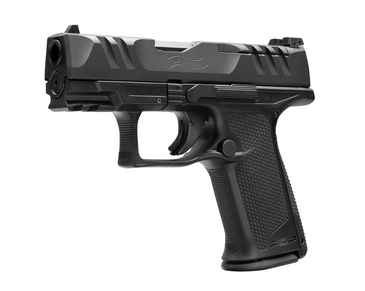
The PDP-F not only competes well in it’s class, with a great reset and trigger.
Holsters are always a concern with newer models, and the PDP-F is no exception. While big-name manufacturers have yet to really step up with custom Kydex or Bolatron, there are plenty of cottage industry types that have stepped up with solid choices for both IWB and OWB carry of the PDP-F.
This One’s a Winner
Walther has happened upon a simple truth that never goes out of style: a quality trigger, short reach to controls, and dependable firing are factors that meet the needs of shooters on just about every band of the spectrum of gun owners. There is no perfect gun but in my estimation, this one comes close.
As a daily carrier of a full-size PDP for work, I love the prospect of having a concealable one, with every component where my hands “expect” them to be, to carry off-duty. I do wish it weren’t quite so wide; its .34 inch difference in width as compared to my P365 makes a major difference in concealability. I’m harboring hope that Walther will see fit to make the PDP in a footprint resembling other robust-capacity micro-compacts.
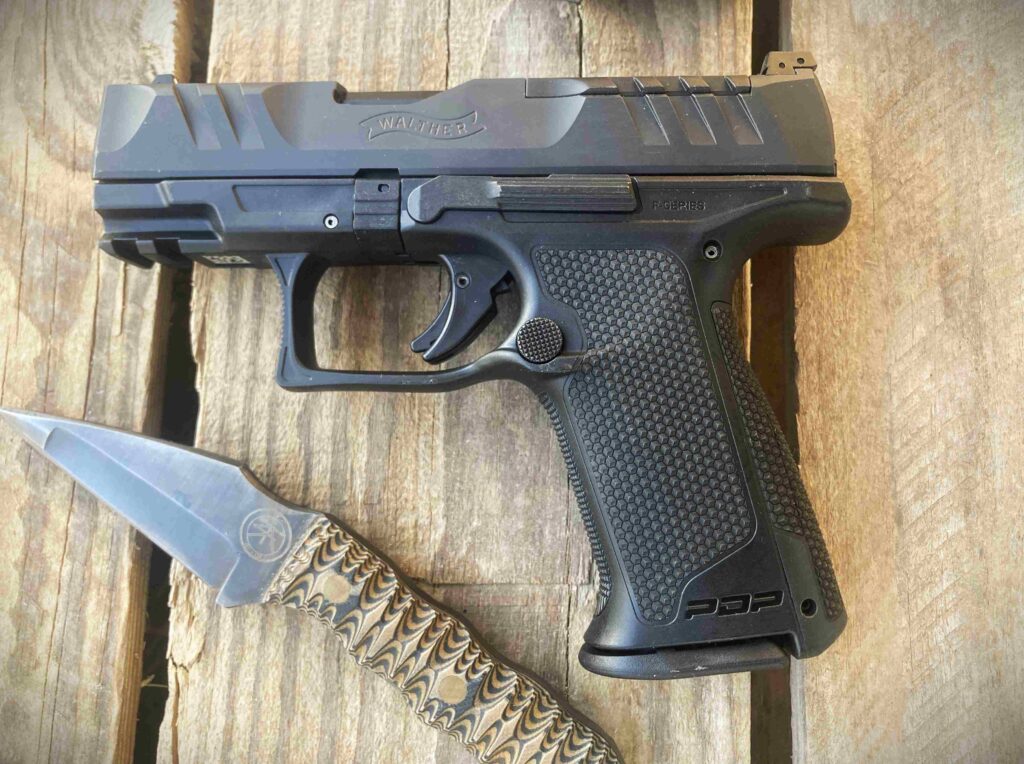
MSRP is steep at $649. I think this value would be well-backed with the inclusion of three magazines, as with the other PDP guns, as well as tritium sights. But regrettably, those aren’t included. Canik’s Mete MC-9 has similar features, an equally outstanding trigger, and is priced at least $100 lower, with market prices nearing $200 less.
The PDP-F is an ideal compact firearm that will suit the needs of many female shooters who want a completely practice-friendly range gun and are willing to work around possible gun size issues for concealment. Men in the market for a quality gun should not be put off by the “F” for female in the name any more than women who are serious about shooting and personal protection are deterred by masculine-centered marketing tactics. It’s a great gun and is currently selling like hotcakes for good reason.
SPECIFICATIONS: WALTHER PDP F-Series 3.5- and 4-Inch
CALIBER: 9MM
COLOR: Black
SLIDE MATERIAL: Steel
FRAME MATERIAL: Polymer
OVERALL LENGTH: 6.5 or 7.5 inches
SLIDE LENGTH: 6.5 or 7.0 inches
WIDTH: 1.34 inches
HEIGHT: 5.4 inches
BARREL LENGTH: 3.5 or 4.0 inches
SIGHT RADIUS: 5.9 or 6.4 inches
TRIGGER REACH: 2.56 inches
GRIP CIRCUMFERENCE: 5.5 inches (without larger backstrap)
WEIGHT WITHOUT MAGAZINE: 20.3 or 21 ounces
WEIGHT WITH EMPTY MAGAZINE: 23.3 or 24 ounces
MAGAZINE CAPACITY: 15 (two included)
SAFETIES: 3 (auto/passive)
TRIGGER PULL: 5.6 pounds
TRIGGER TRAVEL: 0.24 inches
MSRP: 649 USD
To locate a dealer near you visit www.lipseys.com/dealerfinder
About the Author:
Eve is a defensive shooting and lifestyle student, practitioner, and instructor based in the American Southwest. Flanigan holds numerous NRA Instructor certifications and is licensed to instruct New Mexico’s intensive Concealed Carry course. She regularly designs, conducts, and co-teaches classes on concealed carry, introduction to pistol, defensive pistol, basic rifle, last-ditch medical, and use of force for civilian students. Flanigan enjoys competing in run-and-gun biathlons that include carbine and pistol.

